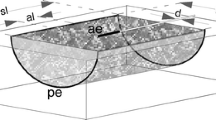Abstract
Radiofrequency ablation (RFA) is a widely used thermal treatment for liver tumors. Knowledge about the resistivity of liver is a prerequisite for the predictability of producible thermo-necrosis with RFA. Most research to date has focused on performing specific experiments to determine the resistivity of a given liver. This work aims to determine the resistivity from the time course of impedance obtained in RFA. We assume that the liver resistivity obeys a piecewise function of temperature. We determine in this work the means and standard derivations of parameters in the resistivity function with finite element analysis of ex vivo bipolar RFA. We experimentally found the temperature at the electrode equal to 125.2 °C. This finding validates a parameter in the function relating to the temperature at which the resistivity starts to rise exponentially. We conclude that it is feasible and reliable to characterize the resistivity function of liver in using the time course of impedance from RFA. This work opens a pathway for the automatic determination of the patient specific resistivity of in vivo liver.








Similar content being viewed by others
References
Ni Y, Mulier S, Miao Y, Michel L, Marchal G (2005) A review of the general aspects of radio frequency ablation. Abdom Imaging 30:381–400
Haemmerich D, Ozkan OR, Tsai J, Staelin ST et al (2002) Changes in electrical resistivity of swine liver after occlusion and postmortem. Med Biol Eng Comput 40:29–33
Haemmerich D, Staelin ST, Tsai J et al (2003) In vivo electrical conductivity of hepatic tumours. Physiol Meas 24:251–260
Zurbuchen U, Holmer C, Lehmann KS, Stein T, Roggan A, Seifarth C, Buhr HJ, Ritz JP (2010) Determination of the temperature-dependent electric conductivity of liver tissue ex vivo and in vivo: importance for therapy planning for the radiofrequency ablation of liver tumors. Int J Hyperth 26:26–33
O’Rourke AP, Lazebnik M, Bertram JM, Converse MC, Hagness SC, Webster JG, Mahvi D (2007) Dielectric properties of human normal, malignant and cirrhotic liver tissue: in vivo and ex vivo measurements from 0.5 to 20 GHz using a precision open-ended coaxial probe. Phys Med Biol 52:4707–4719
Online document: marketsandmarkets.com (2016) Ablation technologies market by product—global forecasts to 2020 . http://www.marketsandmarkets.com/Market-Reports/ablation-devices-market-791.html
Faes TJC, van der Meij HA, de Munck JC, Heethaar RM (1999) The electric resistivity of human tissues (100 Hz-10 MHz): a meta-analysis of review studies. Physiol Meas 20:R1–R10
Mulier S, Jiang Y, Jamart J, Wang C, Chen F, Marchal G, Michel L, Ni Y (2015) Bipolar radiofrequency ablation with 2 × 2 electrodes as a building block for matrix radiofrequency ablation: ex vivo liver experiments and finite element method modeling. Int. J. Hyperthermia 9:1–17
Fatieieva Y, Almendárez P, Romero-Méndez R, Berjano E, Trujillo M (2014) Comparison of enthalpy method and water fraction method to mathematically model water vaporization during RF ablation. J Adv Biomed Eng Technol 1:8–14
Zhu Q, Shen Y, Zhang A, Xu LX (2013) Numerical study of the influence of water evaporation on radiofrequency ablation. Biomed Eng Online 12:127
Byeongman J, Aksan A (2010) Prediction of the extent of thermal damage in the cornea during conductive thermokeratoplasty. J Therm Biol 35:167–174
Haemmerich D, Chachati L, Wright AS, Mahvi DM, Lee FT, Webster JG (2003) Hepatic radiofrequency ablation with internally cooled probes: effect of coolant temperature on lesion size. IEEE Trans Biomed Eng 50:493–499
Yang D, Converse MC, Mahvi DM, Webster JG (2007) Expanding the bioheat equation to include tissue internal water evaporation during heating, IEEE Tran Biomed Eng 54 No8 August
Mulier S, Jiang Y, Wang C, Jamart J, Marchal G, Michel L et al (2012) Bipolar radiofrequency ablation with four electrodes: ex vivo liver experiments and finite element method analysis. Influence of inter-electrode distance on coagulation size and geometry. Int J Hyperth 28:686–697
Jiang Y, Mulier S, Wang C, Rambo MCD, Chen F, Marchal G, Ni Y (2010) Formulation of 3D finite elements for hepatic radiofrequency ablation. Int J Model, Identif Control 9:225–235
Jiang Y, Possebon R, Mulier S, Wang C, Chen F, Ni Y (2016) A methodology for constraining power in finite element modeling of radiofrequency ablation. Int J Num Meth Med Eng. doi:10.1002/cnm.2834
Gresho P, Lee RL, Sani RL (1980) On the time-dependent solution of the incompressible Navier-stokes equations in two and three dimensions. In: Taylor C, Morgan K (eds) Recent advances in numerical methods in fluids. Pineridge Press, Swansea, pp 27–79
Trujillo M, Berjano E (2013) Review of the mathematical functions used to model the temperature dependence of electrical and thermal conductivities of biological tissue in radiofrequency ablation. Int J Hyperth 29:590–597
Neto FDM, Neto AJS (2013) An introduction to inverse problems with applications, ISBN 978-3-642-32556-4. Springer, Heidelberg New York Dordrecht London, p 2
Sachs Lothar (1982) Applied statistics—a handbook of techniques. Springer, New York Heidelberg Berlin, p 321
Ji Z, Brace CL (2011) Expanded modeling of temperature-dependent dielectric properties for microwave thermal ablation. Phys Med Biol. 2011 August 21 56(16):5249–5264
Pätz T, Kröger T, Preusser T (2009) Simulation of radiofrequency ablation including water evaporation. IFMBE Proc 25/IV:1287–1290
Surowiect A, Stuchlyt SS, Eidus L, Swarupt A (1987) In vitro dielectric properties of human tissues at radiofrequencies. Phys Med Biol 32(5):615–621
Veen L (1997) RF laser hyperthermia and radiofrequency ablation of hepatic lesions. Semin Interv Radiol 14:313–324
Miccoli I, Edler F, Pfnür H, Tegenkamp C (2015) The 100th anniversary of the four-point probe technique: the role of probe geometries in isotropic and anisotropic systems. J Phys Condens Matter 27:223201
Wenner F (1915) Bull Bur Stand 12:469
Acknowledgements
This work was partially supported by the grants awarded by the KU Leuven Molecular Small Animal Imaging Centre MoSAIC (KUL EF/05/08).
Author information
Authors and Affiliations
Corresponding author
Ethics declarations
Conflict of interest of statement
The authors declare that they have no conflict of interest.
Rights and permissions
About this article
Cite this article
Possebon, R., Jiang, Y., Mulier, S. et al. A piecewise function of resistivity of liver: determining parameters with finite element analysis of radiofrequency ablation. Med Biol Eng Comput 56, 385–394 (2018). https://doi.org/10.1007/s11517-017-1699-6
Received:
Accepted:
Published:
Issue Date:
DOI: https://doi.org/10.1007/s11517-017-1699-6




